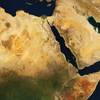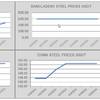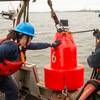Oil-coated Pelicans Being cleaned at Rehab Center
Several petroleum-stained pelicans rescued from the blackened muck of California's latest oil spill spent the day on Friday being gently, painstakingly scrubbed clean at a wildlife rehabilitation center in Los Angeles.
The six pelicans brought this week to the Los Angeles Oiled Bird Care and Education Center in the city's San Pedro harbor area were the first known surviving wildlife casualties from a pipeline rupture on Tuesday about 150 miles away near Santa Barbara.
They were to be joined soon by two more oil-contaminated pelicans from the spill zone, said Christine Fiorello, a veterinarian from the Oiled Wildlife Care Network at the University of California, Davis.
Separately, a young sea lion streaked with petroleum and rescued from the stricken area was sent to the SeaWorld theme park in San Diego to be cleaned up and nursed back to health.
Each bird arrived in San Pedro coated from the tip of its beak and throat pouch to tail feathers and webbed feet in sticky, black grime, a condition that would ultimately prove lethal for the creatures.
Oil impairs the insulating properties of birds' feathers, exposing them to cold and making it difficult for them to float, swim and fly. Chemicals in the crude petroleum also can burn their skin and irritate their eyes, and they end up ingesting the oil as they preen, damaging their digestive tracts.
Teams of wildlife experts garbed in protective suits and face gear spent hours methodically scrubbing and dousing the pelicans plumage and skin, holding fast to their elongated beaks as the birds wriggled and squinted in discomfort.
By the end of the process, the pelicans emerged looking miraculously restored. Footage of the sea lion showed the marine mammal clean and slick after his bathing at SeaWorld.
A network of volunteers and wildlife rescue workers were deployed to the Santa Barbara coast after a 24-inch pipeline that runs along a highway inexplicably burst on Tuesday, unleashing a torrent of crude oil onto the shoreline and into the Pacific.
An estimated 1,700 to 2,500 barrels of petroleum gushed from the pipe before the flow was shut off. Two state beaches were closed to the public indefinitely, and the area has been placed off-limits to fishing.
While the extent of the toll on sea birds, fish and marine mammals has not been determined, experts fear that the eight pelicans and lone sea lion rescued so far may the tip of a potential wildlife calamity.
The spill was the largest to hit the ecologically sensitive shoreline northwest of Los Angeles since a massive 1969 blowout dumped up to 100,000 barrels into the Santa Barbara Channel.
That disaster, which dwarfs Tuesday's accident, killed thousands of sea birds and other wildlife and helped spark the modern U.S. environmental movement.
The birds rehabilitated from the latest spill will be returned to the wild, but there is little data to suggest just how well they are likely to fare once released, Fiorello said.
(Writing and additional reporting by Steve Gorman in Los Angeles; Editing by Robert Birsel)











